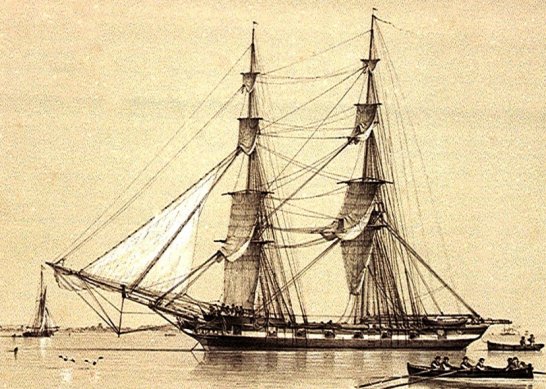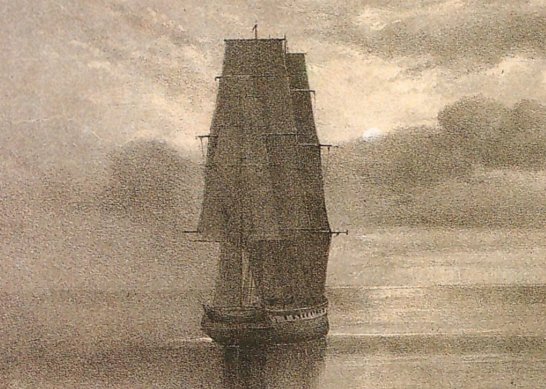

|
Pirate Hunters
HMS Zephyr
 The HMS Zephyr was a 6-gun packet brig-sloop, commanded by Captain Stanley Congalton. The HMS Zephyr was a Cherokee -lass ship - a class of brig-sloops of the Royal Navy. Brig-sloops are sloops-of-war with two masts (a fore mast and a taller main mast) rather than the three masts of ship sloops. Over 110 of these ships were built and they were so flexible that they were also used for exploration and surveys. The best known of the class was HMS Beagle - the ship that took the naturalist Charles Darwin to the Galapagos and laid the foundation for his later work on the theory of natural selection and evolution. The Zephyr was to become one of the Royal Navy's most feared pirate hunters in the waters of the East Indies. Pirate perahus, which used both oars and light sails, were frequently too fast and nimble for the slow, heavy sail ships such as the Magicienne to pursue and destroy. More typically, the British used smaller but faster schooners such as the Zephyr to pursue pirates right up to their coastal and riverine lairs. For example, on the 24th of March, 1835, the boats of the Zephyr fell in with a fleet of thirteen large pirate perahus off Point Romania on the Johor coast. A brisk exchange of musketry ensued between the boats' crews and the pirates, who were subsequently reinforced by five more perahus which emerged from the mouth of a river near Point Romania. Eventually, the ammunition in the boats was exhausted, whereupon the pirates made their escape, having suffered substantial losses. Since there was no wind, the Zephyr had been unable to keep up with their boats, and were too far away to pursue the Malays.
HMS Hyacinth  The HMS Hyacinth was an 18-gun Royal Navy sloop that
took part in anti-piracy operations in the Straits, as well as the
blockade of Kuala Kedah in 1838. After its tour of duty in Malayan
waters, she took part in the First Opium War, destroying, with HMS
Volage, 29 Chinese junks, and from 1843-46 was stationed off the west
coast of Africa in the suppression of the slave trade. Hyacinth
measured 109 ft 6 in (33.4 m) along the gun deck by 30 ft 9 in (9.4 m)
in the beam. She was armed with sixteen 32-pounder carronades and two
9-pounder bow chaser guns. Diana
Royal Navy sailing ships, while heavily armed, were more often
than not unable to keep up with the smaller, faster, nimble boats of
the Malay pirates when there was no favourable wind. Lack of wind did
not present a problem with 'Diana' - the first steam-driven gunship in
the East Indies. It was deployed by the British to hunt Malay and
Illanun pirates preying upon vessels in the Straits from 1837-1845.
With its twin 40 horsepower paddles and speed of five knots, it could
out manoeuvre and outrun the Malay perahus, especially upwind, while
decimating the pirate ranks with its arsenal of Congreve rockets and
rapid rifle fire from the armed sea men onboard. Diana's crew consisted
of the captain, two European officers and thirty armed Malay seamen,
and this could be supplemented by British marine or native police
parties either onboard or, more frequently, towed astern in longboats.
Ironically, in its early encounters with Malay pirates, the pirates
would actually happily attack the ship, mistakenly thinking that the
smoke from her funnels were of a sailing ship on fire and therefore
easy prey. In Diana's encounter with 360 pirates in six perahus off the
coast of Trengganu in 1838, the pirates did just that. To their horror,
the Diana came up close against the wind, and, stopping her paddles as
she came opposite each perahu, poured down rockets and rifle fire that
resulted in 90 of the pirates killed, 150 wounded and 30 taken
prisoner. It was the introduction of this new naval technology that
ensured the Malay pirate soon ceased to be the dreaded scourge and
terror that he was centuries before. Pluto  The steamer Pluto was not only actively engaged in anti-piracy
operations in the Straits of Malacca but also played a pivotal role in
subduing the Malay States, providing British gunship diplomacy during
the Selangor Civil War and the Perak War. The Pangkor treaty was, in
fact, signed on January 20, 1874 on board the Pluto. She was a paddle
steamer that had a speed of 4 knots under her own power, and an
armament consisting of four brass 24-lb. cannons and two brass long
6-pounder chaser guns.
Rinaldo
Improvements in technology in the 1870s meant that Britain
could now deploy bigger, faster and more heavily-armed steam ships such
as the Rinaldo. Built of a traditional wood structure, Rinaldo was 185
feet (56 m) long at the gundeck, 33 feet (10 m) in beam. A barque rig
was fitted to allow easy sail handling with a relatively small crew of
180. It was fitted with a two-cylinder horizontal single-expansion
steam engine driving a single screw propeller. These engines generated
200 nominal horsepower, giving a speed of approximately 9 knots.
Rinaldo was armed with five 40-pounder breech-loading guns and twelve
32-pounder muzzle-loading smoothbore guns. Rinaldo was not only used
against pirates in the Straits and South China Sea but also took part
in the bombardment of Kuala Selangor in 1871 (pictured here),
ostensibly on a mission to capture pirates seeking refuge there. The
pirate hunters had by now very much become Empire builders.
About the WebMasterWrite to the Webmaster: sabrizain@malaya.org.uk
|
|---|